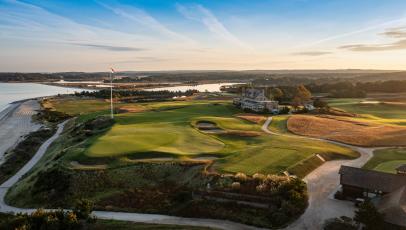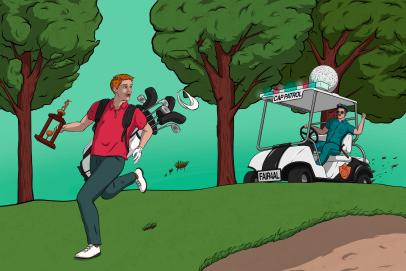If you’re looking for an example of supercharged growth, Austin, Texas, might be the perfect representative. The population for the new tech capital of North America has surged 32 percent since 2010, and more millionaires have relocated there in the past three years than any other city in the United States. As recently as early 2020, the narrative in golf went something like this: Underperforming golf courses would be ideal candidates for conversion to real estate in a booming market like Austin’s, where a 0.15-acre empty lot near the Lions Municipal Golf Course in the Deep Eddy neighborhood goes for more than $1 million. After all, there were more golf-course closures than openings every year from 2004 to 2020. However, COVID changed things—and changed golf, too.
Now the game is poised to take advantage of a massive increase in play from committed players who have more time thanks to work-from-home schedules and a new cohort coming from “adjacent” paths like entertaining experiences blasting balls and enjoying cocktails at a Topgolf. The challenge is making the growth permanent and not a bubble.
Modernizing the Golf Experience
Adam Owens knows the difference between real and transitory growth. Owens runs Magnolia Golf Management, which has owned courses in Austin since 2015. His revenue trend has been straight up since 2015, but the past two years have been particularly strong. The infusion of those tech-focused workers with new-found flex time has filled the tee sheets at Avery Ranch, Teravista and Falconhead from morning to dark. The volume has put so much pressure on the courses’ practice facilities that Owen converted them to synthetic grass with PowerTee automated ball-teeing systems to provide a consistently good practice experience. “When we first started here, it was all about trying to build our customer base,” Owens says. “The growth has been off the charts. Now it’s about figuring out how to give them the best possible experience so that they stay here and stay in the game."
Given his clientele's average level of technical sophistication, it isn't a surprise that Owen was at the front of one of the most important behind-the-scenes trends helping courses everywhere take advantage of their potential clients' increase in unstructured time—and keeping them coming back.
Magnolia moved away from "traditional" golf-course marketing and hired a full-time social-media coordinator who synchronized posts and emails with real-time information from the day's tee sheet. "If we see space, we can send something to our database and post it on our social media, and it's almost a direct one-to one correlation. Online, our times start booking. The response is immediate."

The USGA reported 3 million golfers with official handicaps in 2022 for the first time in its history.
J.D. Cuban
Anecdotes aren’t proof, but Owens’ experience is abundantly represented in the data. The U.S. Golf Association this year reported 3 million players with official handicaps for the first time in its 128-year history—a 16-percent increase since 2020. More than 400,000 of those players were establishing a handicap for the first time. Those players represented more than 75 million rounds played—and 10 million rounds played in Florida alone. Overall, rounds played in the United States in 2022 were 3.7 percent below a record-setting 2021 but still 15-percent higher than 2017-19.
The Changing Definition of Playing the Game
Green grass is just the start of it. There’s a reason why the company you know as Callaway is officially called Topgolf Callaway Brands. In 2022, people spent more money hitting range balls and drinking beer at one of the more than 70 U.S. Topgolf locations than they spent on Callaway equipment. Topgolf contributed $1.5 billion in revenue to the company’s record-breaking year, a 42-percent increase year over year. Callaway bought the 86 percent of Topgolf it didn’t already own in 2020 in an all-stock transaction valued at $2 billion.
The contribution of “off-course” revenue to golf’s recent growth isn’t lost on USGA CEO Mike Whan. “What’s really cool about the industry is that there’s three big buckets of players,” he says. “There are 15.5 million people who play the game only off the course—Topgolf, Drive Shack, driving ranges, putt-putt. That’s what they consider golf, and lucky for us they do. There’s also 13.2 million who play their golf only on a golf course. Then there’s an incredible group in the middle—12.5 million—who play both.”

Off-course participation in 2022 (27.9 million) eclipsed green-grass players (25.6 million) for the first time, according to the National Golf Foundation. Off-course golf includes venues like Topgolf (shown) and businesses with simulator setups.
Topgolf
The infusion of these new kinds of players attracted by a smaller time commitment, less stigma about being a beginner and, perhaps, easy access to cocktails and finger food has made the sport not only larger but less male, less white—and believe it or not—wealthier, Whan says. Considering it can cost almost $100 an hour to rent a top floor bay in prime time at the Las Vegas Topgolf before you even get to food and drinks, it isn’t a surprise to learn that the average Topgolf participant spends more money a year on golf than a public golf participant who plays a round or two per month.
Growing the Game—From the Couch
The bigger pool of golf-interested participants and fans was clearly part of Netflix’s decision to pick up the season-long “Full Swing” documentary series, which followed PGA Tour action from the 2022 season—with the serendipitously spicy LIV origin saga added in as an antagonistic appetizer. “Full Swing” made it into the network’s top 15 most-streamed list on its debut in February, and in March Netflix announced it had picked up a second season, which is being shot now.
As they say in all those advertisements for mutual funds, past performance is not an indicator of future growth, but the golf business must be salivating at the potential for Netflix exposure to change the sport’s financial reach the way it did for Formula 1 racing with its “Drive to Survive” series. “ESPN paid a reported $5 million a season to broadcast F1 through 2022 [in the United States],” says Ampere sports-business analyst Daniel Harraghy. “The new deal—capitalizing on the increased viewership of the sport thanks to Neflix—is valued at $85 million per season.”
What does that look like on the ground for F1? More than a quarter-million fans attended the race in Miami in early May, and the fall Las Vegas race is expected to generate more than $1 billion revenue for the city—double the impact of a Super Bowl. None of that has anything to do with how many times a player pays a green fee or hits a ball, but viewership—live and on television—is what grows the sport’s overall profile.
The PGA Tour’s television deal is locked up through 2030, but there are already indications of a “Netflix effect” on the 2023 ratings. Tournament viewership on CBS is up 4 percent not counting the Masters, and NBC is up 3 percent and Golf Channel is up 9 percent. The final round of the Masters was the most-watched golf telecast of the past five years—up 19 percent over 2022.
The increased television exposure gives players a bigger springboard to promote themselves on their platforms, becoming bigger stars who fans presumably will want to tune in and see, with one important proviso: “You can joke about social media being impacting, but some of it is,” says Max Homa, who gained attention as one of the best follows on Twitter even before he started a stretch of winning play that has propelled him into the top 15 in the world. “I want more people to watch more golf because I love the game of golf. Some of that you can bring on your own—I imagine if you had a YouTube channel, and a lot of people saw you, they would go to the course, and you’d be the one they want to see. But you still have to play well in the big moments at a major or a big event when everyone is watching. That’s how you really impact golf.”
Research by sports-media analytics firm Zoomph reinforces the feedback loop Homa describes. Playing well as more casual fans tune in to see what you’re doing generates more interest—and more revenue—for everyone. Homa’s social media presence was valued at about $2 million for his related brands in 2022—double what it was in 2001. In 2023, that’s projected to double again to $4 million, making him more “valuable” on social media than even Tiger Woods. Just like in his real career, Woods is more about quality than quantity, though. What he loses in frequency (and spontaneity), he makes up in impact: A single post from the GOAT is worth $20,000 in exposure—$6,000 more than one from Justin Thomas, his closest pursuer.

The first season Netflix's docuseries "Full Swing" has attracted fan interest and raised the profile of players like Joel Dahmen (shown here with his caddie, Geno Bonnalie). A second season of "Full Swing" is in the works.
Ben Jared
In F1, Harraghy identified Charles Leclerc (Armani partnership) and Daniel Ricciardo (offshoot Hulu documentary) as drivers who won the exposure game thanks to getting introduced to wider audiences on “Drive to Survive.” Joel Dahmen is having the same kind of moment now. Dahmen went from a virtual unknown before the Netflix series to something of a star after being the focus of a “Full Swing” episode. His social value went from near zero in 2021 to a projected $1 million in 2023—all without winning a tournament since 2021. Dahmen even made the cover of Golf Digest sporting a skin-colored tattooed bodysuit.
That’s probably not what Whan had in mind when he said golf was benefiting from taking on a different look, but emphasizing fun and a bigger tent under which anybody can enjoy all forms of the game has undoubtedly made it more possible for this bump to be bigger and more durable than a bubble.
MORE FROM GOLF DIGEST @ THE PGA CHAMPIONSHIP






